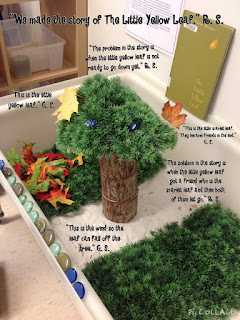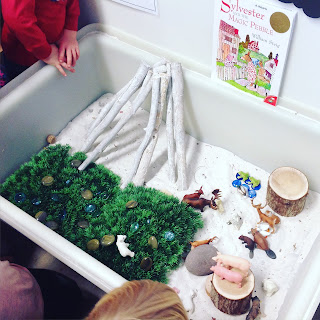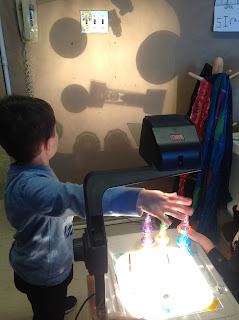I started by asking the children, "What is a story?"
"when mommy or daddy read to you." C. P.
"Something you read to people." K. C.
"Something you make and you read to somebody." M. O.
"Sometimes it's imagination without pages!" P. C.
"Something you made up using your imagination." M. S.
"When you make something up and you draw it." G. S.
"Or tell someone!" Z. G.
"Or build it!" F. D.
"Yea! At construction!" L. B.
"When you read it." M. K.
"Something that you tell people what everything is. Stories have lots of imagination." Z. G.
"It's like my mom, she reads me Author books." D. F.
"Pretending that dogs sit on your lap is imagination!" C. T.
"I like the dog story mom reads to me." A. T.
I enjoyed listening to the different perspectives the children gave to explain what they thought a story was. To begin, I decided to read the story Pezzettino by Leo Lionni and set up a provocation encouraging the children to re-tell or create their own version of the story. This idea was inspired by the wonderful Sunflower School in Orangeville Ontario.
"The yellow squares are the island and these (blue jewels) are the crabs and they're trying to climb on the boat." B. P.
What is the red piece? Mrs. Ralph
"He a person riding on the little boat. He's going to the island. This is the island (yellow pieces) and this is a coconut tree (green pieces) with coconuts (blue pieces)." B. P.
Why do you have so many crabs in your story?
"Because they're all family." B. P.
"This is the sun (yellow pieces) and this is the sky (blue pieces) and these are the clouds (light blue) and this is the little leaves (yellow pieces) for the tree (green pieces). This is the island and these are the frogs (blue jewels) and this is the water guy, the Pezzettino water guy (green pieces horizontal). P. M.
"This is the missing tall creature (small tile pieces) but he's trying to find out if he's somebody's or not. And this is one of his friends (colourful pieces) and he's trying to ask one of his friends if he knows if he's one of his friend's little piece but he's actually really not. He's just his own little creature." C. C.
I encouraged storytelling at many areas in our classroom. With time, the support of the senior kindergarten children, and lots of modeling and sharing, the children became more aware of discussing their ideas collectively, and working together to create.
A few girls brought in their My Little Ponies. This transpired into a lot of pony land creations that included waterfalls, pony lands, gymnastics courses, and gardens for the ponies to pick flowers. I noticed that once the first group created this, it inspired other groups of children to create in a similar way.
"This is Ponyville. This is a castle and a waterfall. There is a jail in the castle. If there is a bad guy running around the big sister pony will rescue the baby pony and the mom pony will get the bad guy and bring them to jail. The big sister pony and the baby pony can go ride down the water slide for fun. There is a path with a flower garden and they can pick flowers and put them in their castle." C. C., B. P., D. F., and C. D.
"We made a kingdom on Pony Island. The story is that the bad guy took the jewel. They took the jewel because they liked rainbow jewels. This is the mud and this is the shell tower. And that's the indoor pool and this is the outdoor pool. And that is a soccer field. These are all the things where to bury the treasures. This is the pony's castle. The bad guys are the white ones and the black ones are the good guys. The solution is that the ponies are gonna get the bad guys all dirty with mud. And then they're gonna stay in there cause they're all muddy. Then they're gonna go to a factory that makes band aids and they're gonna go inside the band aids because they stick to mud and they can't get it off. The shells are the band aid carriers. They turn into band aids and the good guys use them." F. D., K. C., and Z. G.
"We made Pony Lake. It's named Pony Lake because there's a lake and a waterfall and the baby pony is on the boat. This is the gymnastics course for the ponies. The ponies like to go on the boat and go down with a little splash. So they don't fall in we made a little bridge. They live in a castle. This is the merry go round (spools with black fabric). When ponies want to go on a ride they open the curtains and ride."
Why did you use the black fabric? Mrs Ralph
"So the sun doesn't get them burnt." R. S.
"This is the garden with the flowers (red and clear jewels) for them to pick. After the ponies do somersaults they get hungry and they eat (red and clear jewels). They cylinders are for the ponies to hide from the lightening. That's Home Depot. It helps them to buy stuff that they don't have and to build up their house." C. C., R. S., L. S., E. B.
It was very interesting that many of the stories created mixed imagination and fantasy with the children's everyday life experiences.
A few weeks later, I asked the children, "Where do stories come from?"
"They come from books." A. R.
"Imagination." Z. G.
"From a book shelf" J. K.
"They come from the library." A. J.
"When mom and dad read you books." M. N.
"From the structures that you build!" C. C.
"From the author." M. O.
"The authors make up stories from their imagination." M. S.
"We are authors because we make stories." F. D.
"Places we've been to." F. D.
"From what mommy and daddy tell us." J. B.
The children continued to create stories. I noticed how many stories included places the children have been.
Niagara Falls
Camping with family
Creating a park like Canada's Wonderful.
A city with a waterfall and river, restaurant, park, and subway.
Willowdale Farm
A city with a river, apple tree, boat giving rides to people, tower, and garden.
Another city with subway tunnels, towers, apple tree, waterfall and river, and garden.
A city with the addition of a fence to keep the bad people inside.
A city with a jail, towers, waterfall, and bus to take people around.
The structures they created were very detailed and they were always given the chance to share their work with their peers. I loved how they were now using the materials and combining ideas of their personal experiences to create visuals of their adventures. But the more I listened and observed, the more I noticed that their sharing was always done by going to the different structures in their creations and verbally labeling each item (e.g., this is the CN Tower, this is a waterfall, this is an apple tree where the people can go and pick apples, ect.). This was definitely a start towards the right direction, but I was was hoping to find a way to bridge the gap between their detailed creations to acting out their stories.
At our next group meeting, I asked the children, "What do you like about stories?"
"I like the pictures." E. B.
"I like how the author writes the words." R. S.
"I like how the author makes stories using their imagination." C. C.
I then asked them to think about what makes a story enjoyable?
"Stories have an adventure!" Z. G.
"They sure do! What else makes a story enjoyable?" Mrs. Ralph
"There are bad guys and good guys!" B. P.
I also asked the question, "Do you know any stories?"
A list was generated:
The Three Little Pigs
Little Red Riding Hood
Goldilocks and the Three Bears
The Snail and the Whale
The Gingerbread Man
The Princess and the Pea
Don't Let the Pigeon Stay Up Late
This discussion lead us to read and discuss many fairy tales and other stories that concentrated on characters, setting, problem, solution.
"How can stories be told?"
"You can tell your story with your mouth." C. C.
"Make a play." J. K.
"Draw pictures." Z. G.
"Write it down." L. B.
"Take pictures and make a story about them." C. C.
"Paint a story." M. K.
"Use materials to tell the story like in our room!" L. B.
The Little Yellow Leaf
The Three Little Pigs
Little Red Riding Hood
The Three Little Pigs
The Snail and the Whale
The Three Little Pigs
The Snail and the Whale
The Three Little Pigs
"We made the story of The Three Little Pigs. The problem is the wold is trying to eat the pigs. The solution is that the wolf goes down the chimney." L. B., C. D., C. C., C. T.
I was very excited as this was the first group that not only spoke about their structure creations but proceeded to then use the materials to act out the story for their peers. This sharing inspired a few other children.
Little Red Riding Hood
Sylvester and the Magic Pebble
Little Red Riding Hood
Reading a variety of fairy tales and story books, and offering open ended materials really supported the children with their knowledge of storytelling and also extended their creativity and they attempted to act out their stories using the materials. As time passed some children started creating their own stories containing characters, setting, problem, and solution.
"This is Castle Land. The bird has a key on it's tail and when the princess want to get out the bird unlocks it with it's magical powers. This is his nest and he flies back on his nest. This is the pony's water when she gets thirsty. This is a fire in case it's cold and they need to get warm they go close to the fire. Those are the decorations for the draw bridge. The green jewels re is the grass. This is the pumpkin patch and this is the birdie's food. This is a person and he walks around and sees if the acorns and pumpkins are rotten. This is the lake around the castle and when the pony's ever dirty and her hair is yucky then she takes a bath and swishes in the water." R. S. and Z. G.
I continued to leave a basket of fairy tales and other stories we read at the carpet. The interest in storytelling started to fade. But a few weeks ago, I was blown away when a group of children decided they wanted to do a play of Goldilocks and the Three Bears. They worked together to decide who would be what character, they built their set, practiced what they would say, and gave an amazing performance to their classmates! I was so proud of them. All done on their own during Exploration Time while their peers worked at other learning areas! Sharing is so important in that is models wonderful creativity but also inspires others to try new things.
I do wonder what created this change? What inspired the children to suddenly want to act out the plays? How did they get from using materials to re-tell stories to deciding to act them out themselves?
A few other groups of children were inspired and re-enacted other fairy tales for their peers.
* Please note that I will be placing more videos of the numerous plays performed by the children over time. I have run out of space by my provider and need a bit of time to gain more space. Thanks.
Below are photos of plays performed by the children.
The Three Little Pigs
Goldilocks and the Three Bears
Goldilocks and the Three Bears
I anticipated that the plays would only last for a few days, but the interest continues to be sustained. With the exposure of new fairy tales being read, new plays are re-enacted. One fascinating change that has been observed happening in the children's plays is the modification of characters in the stories. They started changing the traditional stories to account for gender. In one re-enactment of Goldilocks and the Three Bears, the three bears included the mom, baby sister, and big sister. There have also been discussions by the children of main characters being able to be boys or girls depending on who is acting. They are quick to tell their peers that the changes are their version and different than the books.
The use of storytelling in the classroom provides children with an abundance of learning skills. It supports self-esteem, confidence, collaboration, and creativity. The Opal School created a list of the learning they noticed from their story workshop. I am placing them below as many skills also apply to the type of storytelling that has been happening in our classroom.
Kate and the Beanstalk
Goldilocks and the Three Bears
Confidence
· making a plan and being held accountable allows me
to see my progress and growth
· making choices about how I spend my time
· giving kids a voice
· any meaning I give to my story, it is still my
story and worthy
· my story is worth telling and sharing
· respecting differences
· there is no wrong way to tell a story
· sharing my stories and feeling secure that it will
be received
· no strict timeline - I can go at my own pace
Creativity
· confidence in using a variety of materials
· exploring a variety of media
· makers vs passive learners
· opportunities to express your thoughts in multiple
ways
· supports inspiration
· not rote
· seeing different perspectives and different
solutions to the same material/problem
· finding new ways to tell a familiar story with a
new material
· ability to explore and create and believe
· materials encourage metaphoric thinking allowing
for many permutations of an idea or object
Compassionate
· Hearing another’s ideas and inherently wanting to
collaborate makes me want to learn about the other - hear your story -
diversity
· fosters deeper connections between people, animals,
nature
· problem solving with friends allowing to offer or
receive a helping hand
· safety to share your idea knowing it will be
received well
· see and understand different perspectives of same
event
· problem solving through play - authentic
· gives children the opportunity to “stay with
friend, holding a strong image of their potential”
· seeing we have more in common - we have more that
brings us together than apart
Leadership
· knowing that your story is important and you can
make your voice be heard
· inviting friends in to listen and validate your
story
· cultivates desire to support others
· empowering ownership of stories
· taking a risk and practicing sharing and
expecting to both be heard and to contribute to the interaction
· teaches kids to be mindful, intentional about
choices
· what I say has value
· helping others and the ability to be helped
· I am valuable and important. What I say matters
Karlsen, Matt. "Why story workshop?" Opal School Blog. Tuesday, October 7, 2014. http://opalschoolblog.typepad.com/opal-school-blog/story-workshop/ . Sunday, January 24, 2016.









































































































